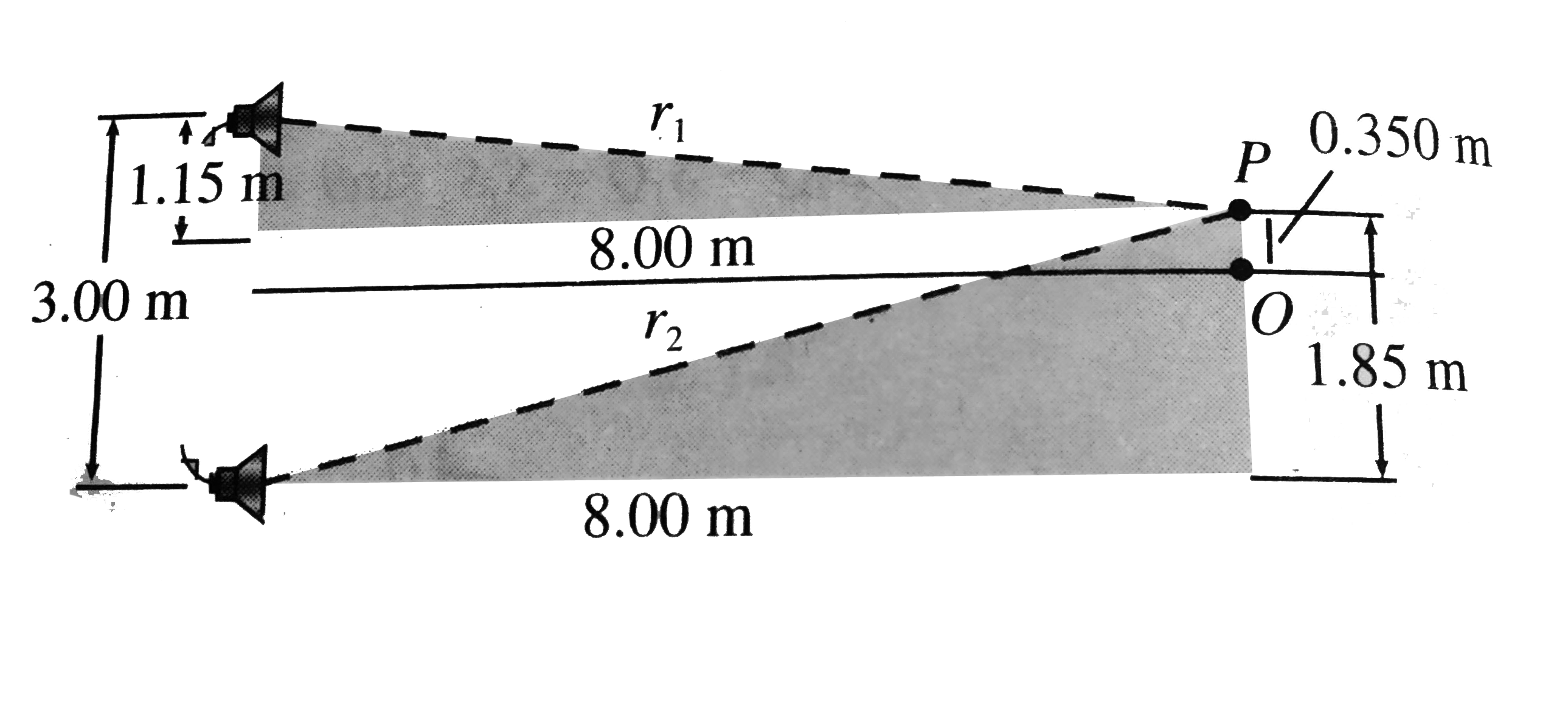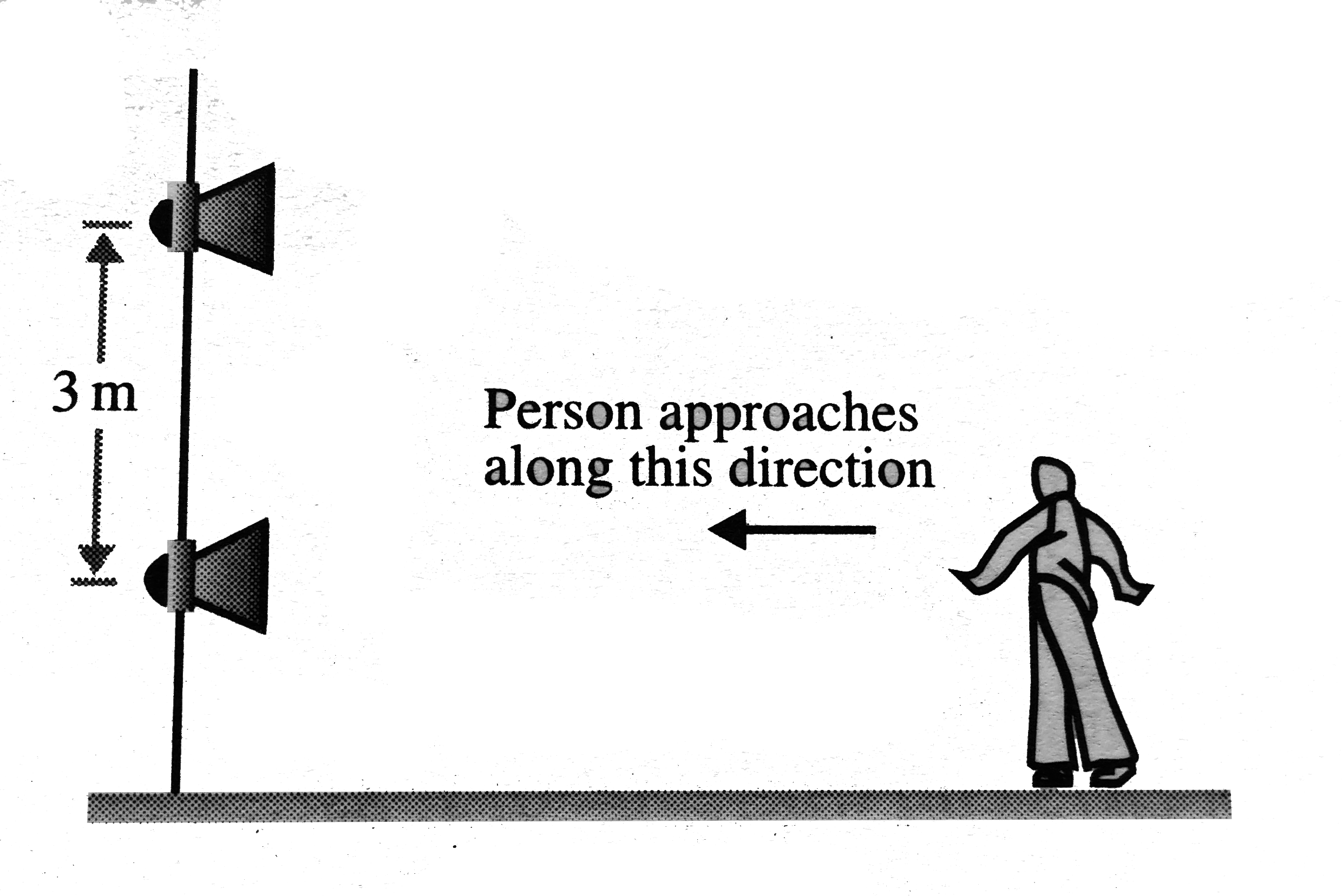Two identical loudspeakers placed 3.00m apart are driven by the same oscillator as shown in Fig. 7.12. A listener is originally at point O , located 8.00m from the centre of the line connecting the two speakers. The listener then moves to point P, which is a perpendicular distance 0.350m from O , and she experiences the first minimum sound intensity . What is the frequency of the oscillator ?

In this example , signal representing the sound is electrically split and sent to two different loudspeakers . After leaving the speakers , the sound waves recombine at the position of the listener. Despite the difference in how the splitting occurs , the path differnce discussion related to Fig . 7.12 can be applied here.
Because the sound waves from two separate sources combine , we apply the waves in interference analysis model. Figure 7.12 shows the physical arrangement of the speakers , along with two shaded right triangles that can be drawn on the basis of the lengths described in the problem . The first minimum occurs when the two waves reaching the listener at point Pare180∘ out of phasw , in other words , when their path difference Δrequalsλ/2.
From the shaded triangles , find the path lengths from the speakers to the listener :
r1=√(8.00m)2+(1.15m)2=8.08m
r2=√(8.00m)2+(1.85m)2=8.21m
Hence, the path difference is r2−r1=0.132m. Because this path differnce must equal λ/2 for the first minimum , λ=0.26m. To obtain the oscillator frequency , use equation v=λf, where v is the speed of sound in air , 343m/s.
Similar Questions
The distance between the two identical speakers shown in Fig. 14.3.3 are 4.00m. They are driven by the same osicllator. Initially a listner stays at L at a distance 8.0 m from the centre of the line connecting the two speakers. The listner then walks to the point A where AL=0.4m. The first minium is sound intensity in heard just the listener reaches the point A. Find the frequency of the oscillator. Speed of sound in air is 340 m/s.
View SolutionTwo identical loudspeakers are driven in phase by a common oscillator at 800Hz and face each other at a distance of 1.25m. Locate the points along the line joining the two speakers where relative minimum of sound pressure amplitude would be expected. ( Use v=343m/s.)

View Solution
Knowledge Check
Two loudspeakers are located 3 m apart on the stage of an auditorium. A listener at point P is seated 29.0 m from one speaker and 25.0 m from the other. A signal generator drives the speakers in phase with the same amplitude and frequency. The wave amplitude at P due to each speaker alone is A. The frequency is then varied between 20 Hz and 300 Hz. The speed of sound is 343 m/s.
At what frequency or frequencies will the listener at P hear a maximum intensity?A170 Hz onlyB57 Hz, 113 Hz, 170 Hz, 227 Hz, and 284 HzC113 Hz and 226 HzD86 Hz, 170 Hz, 257 HzTwo loudspeakers are located 3 m apart on the stage of an auditorium. A listener at point P is seated 29.0 m from one speaker and 25.0 m from the other. A signal generator drives the speakers in phase with the same amplitude and frequency. The wave amplitude at P due to each speaker alone is A. The frequency is then varied between 20 Hz and 300 Hz. The speed of sound is 343 m/s.
Determine the value of the maximum amplitude in terms of A.A2.0AB3.0 AC2.5 AD4.0AAn oscillator of frequency 680Hz drives two speakers . The speakers are fixed on a vertical pole at a distance 3m from each other as shown in Fig. 7.103. A person whose height is almost the same as that of the lower speaker walks towards the lower speaker in a direction perpendicular to the pole. Assuming that there is no reflection of sound from the ground and speed of sound is v=340m/s , answer the following questions.

How far is the person from the pole when he hears a minimum in sound intensity a second time ?A5.6mB7.8mC12.4mD17.6m
Two identical loudspeakers are driven in phase by a common oscillator at 800Hz and face each other at a distance of 1.25m. Locate the points along the line joining the two speakers where relative minimum of sound pressure amplitude would be expected. ( Use v=343m/s.)

View SolutionTwo identical loudspeakers are located at point A & B,2m apart. The loudspeakers are driven by the same amplifier (coherent and are in phase). A small detector is moved out from point B along a line frequency below which there will be no position

View SolutionTwo identical loudspeakers are located at point A & B,2m apart. The loudspeakers are driven by the same amplifier (coherent and are in phase). A small detector is moved out from point B along a line frequency below which there will be no position

View SolutionAn oscillator of frequency 680Hz drives two speakers . The speakers are fixed on a vertical pole at a distance 3m from each other as shown in Fig. 7.103. A person whose height is almost the same as that of the lower speaker walks towards the lower speaker in a direction perpendicular to the pole. Assuming that there is no reflection of sound from the ground and speed of sound is v=340m/s , answer the following questions.

How far is the person from the pole when he hears a minimum in sound intensity a second time ?
View SolutionAn oscillator of frequency 680Hz drives two speakers . The speakers are fixed on a vertical pole at a distance 3m from each other as shown in Fig. 7.103. A person whose height is almost the same as that of the lower speaker walks towards the lower speaker in a direction perpendicular to the pole. Assuming that there is no reflection of sound from the ground and speed of sound is v=340m/s , answer the following questions.

As the person walks toward the pole , the total number of times that the person hears a minimum in sound intensity will be
View Solution
